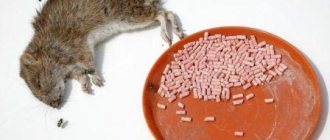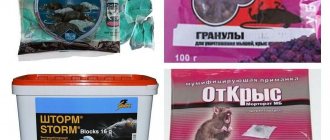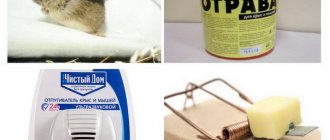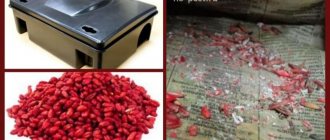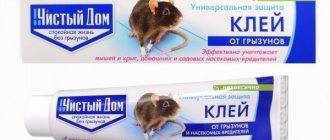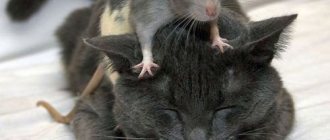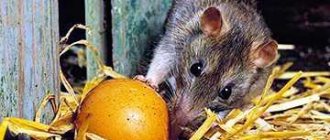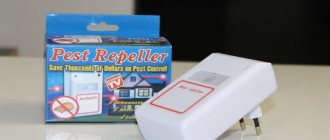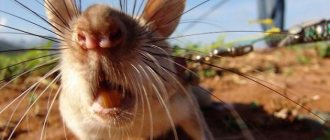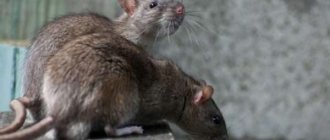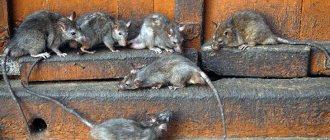There are two types of rat baits: food (non-toxic) - for luring rats into a trap, and poisonous - for killing rodents. Food baits can be used for all types of rat traps, and poisons are most often used in conjunction with special stations for safety reasons. In this review we will talk about the 8 best poisons for rats and mice.
After ingesting poison, rodents die within a few hours to several weeks. Mice are smaller than rats and can die within a day, but rats die more slowly (a week or two). Poison baits are toxic and can kill any animal, including pets (cats and dogs), squirrels, raccoons and other wild animals. Be careful when using them around your pets and small children. Otherwise, instead of using poisons, you are better off purchasing an ultrasonic pest repeller to safely eliminate the animals that are bothering you.
Plastic container for mice
In order for poisoned baits to have maximum effect, special plastic bait containers should be used. They are used by pest control agents.
Their advantages:
- the poisonous bait is protected from atmospheric influences (wind, rain);
- equipped with a drinking bowl and a special place for poison;
- To attract the attention of rodents, the entrance resembles a hole.
Poison reserves can be easily and conveniently replenished; this is exactly what the design is designed for.
What is the best bait to use for traps?
There are many options to choose from – you just have to know the best way to replace your rodent trap. We remind you that for this you need not poisoned bait, but food or natural bait! You must choose the best way to lure unwanted neighbors inside the trap. This is a necessary step because if the bait does not attract rats, they will never fall into the trap - and your rat problem will never be solved.
Have you heard of the “great rat eradication”? This is an example of a large campaign aimed at getting rid of rats en masse. We hope that those reading this article have only encountered a small population of rats in their home - and using natural baits in traps will help solve the problem of catching and killing rats.
You can choose any of the following options:
- Peanut Butter: This is actually more effective than the cheese we often see in rodent cartoons. Rats are very attracted to peanut butter.
- Chocolate: The sweet smell of chocolate makes mice and rats come out of their hiding places to enjoy this treat.
- Bread: Plain bread or bread with a little butter on it is very effective as bait.
- Ropes, cotton wool: excellent materials for bait. Rodents use them to strengthen and insulate their nests.
Bromadiolone
Poison of the anticoagulant group. Once in the stomach of a rodent, it disrupts the synthesis of proteins of the prothrombin complex. Supplied as a liquid concentrate (0.25%) in 1.1 liter containers. In addition to the food base, attractants are recommended: unrefined sunflower oil, sugar. Any operations (cooking, laying out) are performed in special clothing and gloves.
Mass pest control products are toxic and 100% effective only when used correctly, so only certified specialists can use them. In this case, they are safe and the goal will be achieved.
Poison Ingredients: How Do Rodenticides Really Work?
Rodenticides are toxic to rodents, but, unfortunately, to humans too. All these baits bring death. Therefore, rat poisons are best used in conjunction with stations (like the Protecta LP Rat Bait Station for ~$18.49).
The active ingredients in rodenticides, which are classified as anticoagulants (such as warfarin, diphasinone, and bromadiolone), interfere with blood clotting, causing severe internal bleeding and ultimately death.
Products containing active substances other than anticoagulants are toxic in various ways. They can affect the nervous system (for example, bromethalin). They increase calcium levels in the blood, leading to kidney, liver or heart failure (eg cholecalciferol).
All poisons also belong to two different generations.
First generation poisons kill rodents slowly because they have a cumulative effect. For rodents to die, they need to eat the poison for several days, rather than just taste it once. Most rat and mouse baits these days fall into this group.
Second generation poisons (for example, containing bromadiolone, brodifacoum) can kill pests after just a single dose of the poison.
Poisons come in both block, granule and bar form (individually wrapped to help maintain the freshness and smell of the bait), etc.
- Using poison bait is usually less expensive than trapping because it is less labor intensive and rats do not have to be checked every day. Thus, in large rooms it is more profitable to use poisons.
- You should be aware that mice and rats can learn to identify baits and avoid them. To prevent this, scientists advise first laying out food bait to lull the vigilance of rodents, and then replacing it with a poisoned one.
- Liquid rat poison works great in dry areas.
Poisons and animals (cats, dogs)
Please note: There are no rat poisons that are safe for your pets! All poisonous baits are created to kill animals and can also harm cats and dogs. Be very careful: if the poison is swallowed, severe poisoning can occur. If you are concerned about pets, try an alternative method: electronic repellers. To get rid of rats, use only powerful repellers with a large area coverage.
User Cesar Rueda of the site warns: “Please be very careful when using bait if you have a dog. She won't be able to get into the bait station, but many rodents have a tendency to pull out and hide bits of poison all over the backyard..."
To prevent your cats or dogs from accidentally eating poison in the yard, you can, for example, attach poison to a strong wire on the fence or hide pieces of the toxic product in places where your pets do not go - and then wait for the dead rats.
“Just use the poison in garages and attics – ie. in areas where your children and pets would not normally go. It is possible that dying rats or mice will go outside and be eaten by other animals (though if you live in an urban area the likelihood is low compared to rural areas), but usually most die near the area where you used the product. After the death of a rodent, an unpleasant odor will certainly appear, which is why the poison must be used with caution in places where it will then be difficult to find the corpse and remove it.”
Yes, poisons kill rodents. But you don't know where exactly they will die. Dying rodents are looking for a quiet place, and you will be lucky if they manage to get outside. But it is possible that their death will happen right in your house or barn, then an unpleasant surprise awaits you - the smell of dead rats.
How to prepare poison for mice at home that is safe for other animals
You can make poison for uninvited guests yourself, using improvised means . These baits will be completely safe for humans and pets.
Their action is not as fast as that of chemical drugs, so you can completely get rid of mice in several procedures.
Recipes for preparing poison.
- Mix buckwheat with alabaster in a ratio of 1:3. Place a container of water next to the bait. After a meal, the rodent will want to drink, which will lead to swelling of the alabaster inside.
- Combine sugar with quicklime in a 1:2 ratio. Rodents will not ignore the sweet powder, and when lime reacts with moisture, gases will begin to be released, the temperature will rise and the stomach will swell. This will lead to inevitable death.
- Mix gypsum with corn flour in equal quantities. Add a little warm milk to the mixture to form a stiff dough. Roll the resulting mass into balls and place them in rodent habitats. The plaster in the stomach will harden and clog the rodent's intestines.
Be sure to read:
How to deal with mice in an apartment, what to do: effective methods and means
Popular rat control products
You can purchase poison at any specialized store. When choosing, you should be guided not only by price, but also by other characteristics.
"Ratsid"
This is a highly toxic product (it is not fatal to humans, but precautions must still be taken). The lethal dose for a rodent is 20–25 mg. After eating food with “Rat”, the rodent dies from suffocation within 12–72 hours. If the poison does not work, the rat will develop immunity. "Krysid" can be used in different ways:
- spray into holes;
- mix with bait (it should be placed 3-4 days after feeding with non-poisoned food);
- pour into water.
"Krysid" is toxic to rats and can also cause poisoning in pets
"Ratox" and "Commando"
They are made on the basis of zinc oxide. Such means are much more dangerous than “Ratsid”. When zinc phosphide enters the digestive system, it begins to react with hydrochloric acid, releasing highly toxic hydrogen phosphide, which kills the rodent.
Ratox cannot be used in residential areas
These products have a specific odor and can react even with air, so their use in residential areas is strictly prohibited.
Commando poison easily reacts with air
An effective means of baiting rats over a large area
The main means of fighting over large areas are:
- bait houses. Food containing poison is placed in them. They place houses in places where there are large concentrations of rodents. When a rodent comes inside, the house closes;
- treatment of burrows with rodenticides (poisons in powder form). Particles of the product fall on the fur, and then when licked inside the animal;
- filling holes Rats can chew through most materials, even concrete. Therefore, it is better to cover the holes with metal sheets or a wall made of cement, shells and crushed glass;
- traps and traps. Most often they have a wooden base. It is difficult to catch a rodent with such devices; they can only be used in secluded places once, since rats leave their odors, warning their relatives of danger;
- carbonation. A poisonous gas based on hydrogen phosphide or carbon monoxide is sprayed into a closed room. This mixture does not harm food products and disappears quickly, leaving no odor.
Small size is deceptive as the rat can be fast and agile
Reviews about the drugs
- One morning I saw a large rat sitting on a trash can in the kitchen. She was not very willing to run away from my movements. Living on the second floor of a nine-story building, I immediately went for a means of dealing with a dangerous, unpleasant animal. The first product I came across was “Tsunami”. Having laid out the pink tablets in accordance with the instructions, near the water pipes in the kitchen, I noticed their disappearance the next day. The rat did not appear again. The place is difficult to reach. I take the pills often. Marina .
- Infestations of rats and mice in the country are common. Especially at the beginning of autumn. I spread rat poison on the veranda and kitchen. Everything was eaten. I didn’t find any corpses, but the rats didn’t appear again. In the spring there were no signs of rats. Valentina.
- In late autumn I used Zookoumarin powder. I forgot a bucket of water on the veranda. Arriving at the dacha two weeks later, I was horrified to find a full bucket of swollen corpses. I had to bury it urgently. Perhaps this is one of the particularly effective methods of struggle. I didn’t see any more rats in the dacha. Only small autumn mice. Lyudmila.
Smoke bombs
Such products are effective and inexpensive. In addition, with the help of smoke bombs you can get rid of not only annoying rodents, but also fungus, mold, various insects that poison life and even ticks. However, such products should also never be used in city apartments.
The active component of these drugs is sulfur. To use a checker, you must first study the instructions for a specific product in detail. After this, you need to remove flowers, food, and animals from the premises being treated. Once ignited, the bomb begins to emit very acrid smoke. It penetrates into all the cracks and corners of the room. Thus, pests are practically smoked out of the house. During the burning of the checker, you need to carefully monitor that a pet does not enter the house or a child runs into it. After treatment, you can forget about many pests for quite a long time. But many note the difficulty of using this method, which is why smoke bombs are at the end of the list in the rating.
Source
The mechanism of action of the poison
It is impossible to say for sure how rat poison acts on mice.
It all depends on the main active ingredient of the drug and the additives included in its composition.:
- Warfarin-based drugs act on the circulatory system of the rodent. They lead to blood thinning and the spread of hemorrhages.
- Preparations containing zinc phosphide affect the respiratory system.
- Baits containing arsenic depress the rodent's nervous system.
- Phosphorus-based products destroy bone tissue.
In addition, there are drugs containing dicumarol, diphenacin, phentolamine, kemochlor, which, when accumulated inside the body, lead to failure in all internal organs and the slow death of mice.
Barium fluoroacetate and glyftor cause the blood to rapidly clot, killing the animal almost instantly.
How long will it take for a rodent to die?
How long it takes for mice to die from poison depends on two main factors: the composition of the drug and the amount of bait consumed.
A poison with a delayed effect will only take effect when a sufficient amount of poison has accumulated in the body.
If a toxic substance is supplied in small quantities over a long period of time, there is a high probability of resistance developing in rodents. That is why baits need to be replenished.
Instant poisons kill mice within a few hours. A poison with a delayed effect begins to act on days 2–3 if a lot of bait has been eaten.
If not, it is necessary for the poison to accumulate and cause disruption in the functioning of all systems of the rodent’s body. This may take from 3 to 10 days. This is why many owners begin to think that the poison has no effect on the mouse.
Precautionary measures
Rat poison is also dangerous for humans, however, due to the low concentration in all products produced, the possibility of death tends to zero. But intoxication is possible, which is manifested by the following symptoms:
- headache;
- pallor;
- severe weakness;
- nausea;
- loss of appetite;
- bleeding of mucous membranes and gums.
The finished bait should be used according to the manufacturer's recommendations.
At high doses of rodenticide the following are possible:
- abdominal pain;
- diarrhea;
- vomit;
- blood in the stool;
- the appearance of hematomas on the body;
- fainting.
To prevent such manifestations, it is necessary to observe the following precautions:
- work with poison in a respirator, thick rubber gloves, safety glasses and a change of clothes;
- use modern means, since outdated drugs are too toxic;
- place poisonous baits in areas restricted for pets and children;
- when the first signs of intoxication appear, immediately call an ambulance;
- Before using poison, consult a specialist on the choice of drug and the required dosage.
The remains of the bait must be thrown into a hole about 1 m deep, away from living quarters.
Note! Rodents can often drag parts of baits over long distances, leaving them there.
Rodent control is always a complex process, including not only the installation of traps, but also their regular checking and replenishment. At the same time, the safety of all inhabitants of the house is extremely important.
